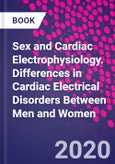Sex and Cardiac Electrophysiology: Differences in Cardiac Electrical Disorders Between Men and Women is a comprehensive investigation into all aspects of sex differences in cardiac electrophysiology. As there are substantial differences between female and male patients in physiology, pathology triggering factors, disease progression, clinical approaches and treatment outcome, this book provides a comprehensive examination. In cardiology, the differences between women and men are more recognized, hence this title summarizes these important differences, providing the essential information needed for clinical specialists and researchers involved in the design and implementation of clinical studies.
Please Note: This is an On Demand product, delivery may take up to 11 working days after payment has been received.
Table of Contents
Introduction 1. Distinction between sex and gender 2. What is sex good for?Cellular and Tissue Electrophysiology 3. Sex differences in cardiac ion channels 4. Atrial and ventricular tissue electrophysiology 5. Cardiac conduction system
Electrocardiography 6. Morphology of normal resting electrocardiogram 7. QRS duration 8. Sex differences in QRS fractionation and slurring abnormalities 9. QT interval and QT/RR relationship 11. T wave morphology and ventricular gradient 12. T wave alternans 13. Sex-specific definitions of electrocardiographic abnormalities
Cardiac Autonomic Regulation 14. Baseline autonomic characteristics 15. Cardiac autonomic responses to provocative stimuli 16. Circadian pattern of autonomic status
Effects of Sex Hormones 17. Electrophysiological cellular effects of sex hormones 18. Development of electrocardiographic sex differences during puberty 19. Electrophysiologic changes during menstrual cycle 20. Electrocardiographic changes after heart transplantation 21. Cardiac rhythm changes during menopause
Channelopathies 22. Congenital long QT syndrome 23. Congenital short QT syndrome 24. Brugada syndrome
Drug-Induced Electrophysiology Abnormalities 25. Mechanisms of drug-induced QT interval prolongation 26. Mechanisms and incidence of Torsade de Pointes tachycardia
Training and Sport 27. Electrophysiological adaptations to endurance and strength training 28. Exercise-based cardiac rehabilitation 29. Arrhythmias due to athletic training
Cardiomyopathies and Inherited Disorders 30. Hypertrophic cardiomyopathy 31. Dilated cardiomyopathy 32. Arrhythmogenic right ventricular cardiomyopathy 33. Catecholaminergic polymorphic ventricular tachycardia 34. Cardiac electrophysiology in sex chromosome aneuploidies 35. Takotsubo syndrome
Supraventricular Tachycardias 36. Supraventricular ectopies 37. Focal supraventricular tachycardia 38. Accessory pathway and atrio-ventricular reentrant tachycardia 39. Atrioventricular nodal reentrant tachycardia 40. Inappropriate sinus tachycardia 41. Ablation of nodal and atrio-ventricular accessory pathways
Atrial Fibrillation 42. Rate control of atrial fibrillation 43. Cardioversion 44. Catheter ablation of atrial fibrillation 45. Demographics and procedural data differences of AF ablation 46. Monitoring and follow-up after atrial fibrillation ablation 47. Thromboembolic risk and anticoagulation therapy 48. Quality of life with AF
Myocardial Ischemia and Infarction 49. Electrocardiographic manifestation of suspected acute coronary syndromes 50. Acute MI and cardiogenic shock arrhythmias 51. Arrhythmias of subacute phase of MI 52. Sex-specific arrhythmia risk of post-MI follow-up 53. Sex Differences in Intensive Care Unit Electrocardiographic Alarms 54. Predictive value of admission electrocardiography in heart failure
Ventricular Tachycardias 55. Ventricular arrhythmias associated with structural heart disease 56. Catheter ablation of ventricular arrhythmias associated with structural heart disease 57. Idiopathic ventricular arrhythmias 58. Mapping and catheter ablation of idiopathic ventricular arrhythmias
Electrophysiology in Pregnancy 59. Hormonal and autonomic electrophysiologic effects of pregnancy 60. Supraventricular tachycardias during pregnancy 61. Atrial fibrillation during pregnancy 62. Ventricular tachyarrhythmia during pregnancy 63. Pregnancy in congenital long QT and Brugada syndrome patients 64. Pregnancy and implanted devices 65. Fetal arrhythmia in intrahepatic cholestasis of pregnancy
Sudden Cardiac Death 66. Demographics and epidemiology 67. Sudden Infant death syndrome 68. Cardiac risk in the young 69. Sex-specific mechanisms of sudden cardiac death 70. Sex-specific risk assessment of sudden cardiac death
Drug Therapy 71. Safety and efficacy of antiarrhythmic drugs 72. Dose responses in acquired long QT syndrome 73. Acquired long QT syndrome and sex hormones 74. Management of arrhythmias in pregnancy
Device Based Therapies 75. Antibradycardia pacing 76. Primary and secondary prevention of SCD in women 77. Utility of Implantable cardioverter-defibrillators 78. ICD registries and sex-specific metanalyses 79. Clinical experience with the use of CRT in women 80. CRT registries and sex-specific metanalyses 81. Lead extraction in women 82. Quality of life with implanted devices
Outlook 83. Obstacles for enrolment of women in clinical trials 84. Regulatory implications of sex differences in clinical trials








